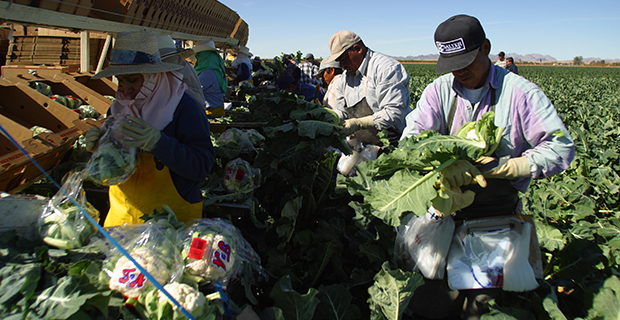Under the cover of darkness for safety
John Boelts, Dave Puglia, Ken Narramore & Mike Pasquinelli, Guest Commentary//November 14, 2025//
Under the cover of darkness for safety
John Boelts, Dave Puglia, Ken Narramore & Mike Pasquinelli, Guest Commentary//November 14, 2025//
Those in agriculture possess tons of great data and insights to share about the revolution of safety in the crop protection world, otherwise known as pesticides. Unfortunately, information must be clarified. Notably, the article, The human cost of the Yuma’s vegetable empire, affords us the opportunity to set the record straight.
Arizona farmers take what they do each day very seriously — how their farming impacts their families, their workers, their neighbors, their community and consumers. They are not going to take actions that would cause harm to people or the environment. They undergo hours of training and use the best technology available to ensure what they do is safe. Let us explain.
The article begins with, “under the cover of darkness, pilots drop thousands of pounds of pesticides over fields…” alluding to the idea the farmers have something to hide. Aerial applications are conducted at night to reduce drift, when night air is typically calmer, and to protect field workers and farmers who are not in the fields in the evening. Evening applications are also for our pollinators since bees return to their hives at night. These evening aerial applications are simply for safety.
Significantly, record keeping is required for all crop protection applications. In addition, highly trained Pest Control Advisors (PCAs) complete their pest management recommendations on Form108. These Arizona Department of Agriculture forms can be accessed, examined and evaluated.
Those thousands of pounds of pesticides referenced in the article represent crop protection products applied at “ounces per acre.” These crop protection products are very selective against damaging pests, safe to non-target organisms, and are not persistent in the environment.
Next, we read, “A few hours later, legions of farmworkers head to these same fields…” What’s important to know is the United States Environmental Protection Agency (EPA) sets reentry restrictions on all registered pesticides. These mandatory restrictions prevent workers from entering fields following an application until it is deemed safe to do so. Based on the specific crop protection used, reentry restrictions vary and may be as little as 4 hours to as much as 72 hours later. Hence, when pesticides are applied under the cover of darkness and the reentry clock starts ticking when farm workers are out of the field, evening applications become an added benefit.
Yuma has been growing high-value specialty crops for decades. The leafy greens grown in Yuma and other areas of Arizona are not a new shift in growing crops.
A large, long-term and ongoing longitudinal study called the Ag Health Study does not support the article’s claim that, “In rural agricultural areas where people are working on farms, there are higher incidences of diabetes, obesity, pulmonary issues, endocrine disruption, cancer. …”
Another statement by the article claims, “The science is nearly 60 years old; however, the impact of these pesticides remains alarmingly current, with comprehensive studies conducted over the past 20 years.” The studies alluded to are epidemiological studies that do not show a cause and effect. In truth, and more importantly, the EPA requires and reviews data that show a “dose and response, cause and effect.” EPA has also reviewed these epidemiology data and where they meet the standards set in the law to be reliable and available data, they are used by EPA as part of the decision-making process on whether to register a pesticide, and how to label it or to re-register it. Every pesticide registered by EPA must be re-evaluated at least every 15 years to consider all new information. In many cases, registered pesticides are reviewed more frequently.
Overall, it takes 12 years to bring a new crop protection product to market with an average of $286 million spent on research by the company developing it. The EPA requires data and assesses any potential endocrine effects, making the dose and response, cause and effect proofs of safety to be met. And even then, the product can be terminated by regulatory authorities. Today, pesticides are often termed “soft pesticides” as they only target the “bad” pests, leaving beneficial bugs, such as ladybugs and butterflies, to do their battle against “bad pests.”
Ultimately, the EPA considers all data, including epidemiology data, conducted by independent scientists and universities. EPA requires registrants – the organizations developing a new crop protection product – to conduct and submit their research results. The EPA independently verifies and validates that data to be sure that when the pesticide is registered for use, it meets the safety standards set in U.S. law.
Finally, the article states, “They (EPA) do not currently study any of the active ingredients that go into pesticide products sufficiently.” This is not true. EPA has a framework for doing cumulative risk assessments on pesticides and has conducted that review for organophosphates, carbamates and other classes of pesticides. The EPA also looks at synergistic effects.
Ultimately, no product is 100% risk free, including organic pest control products, but the products used today are orders of magnitude safer for humans and the environment than products of the past. To apply these much safer and improved products, all growers, pest control advisers and applicators are state licensed, and are required to obtain annual training in continuing education units to maintain their license. Plus, all workers entering the produce fields receive annual pesticide training in an understandable manner (language and literacy) before ever being allowed into the fields.
While the agriculture community harbors profound concerns about the “Human Cost” article’s inadvertent misrepresentation of our dedicated, multifaceted efforts in Food Safety and Human Health, efforts born of a deep-rooted commitment to nurturing both land and lives, we see this as a hopeful opportunity to share our story with distinction and openness, bridging divides through shared appreciation and mutual respect for America’s food system, the safest in the world.
Submitted by Arizona Farm Bureau President John Boelts, Western Growers President and CEO Dave Puglia, Arizona Crop Protection President Ken Narramore, and Yuma Fresh Vegetable Association President Mike Pasquinelli.














































